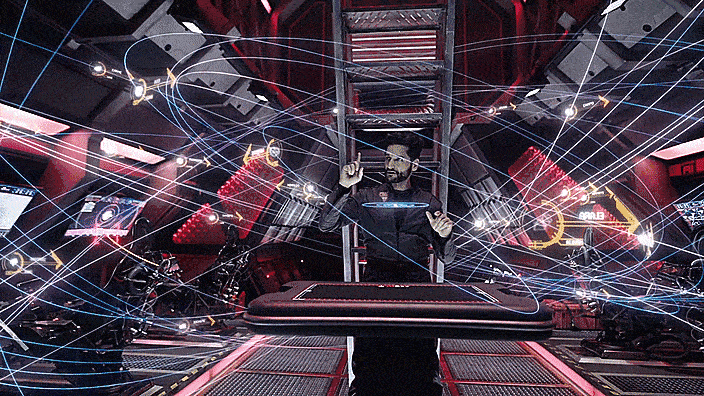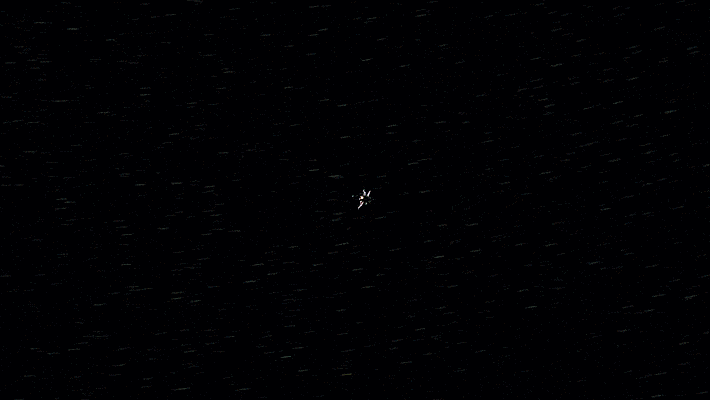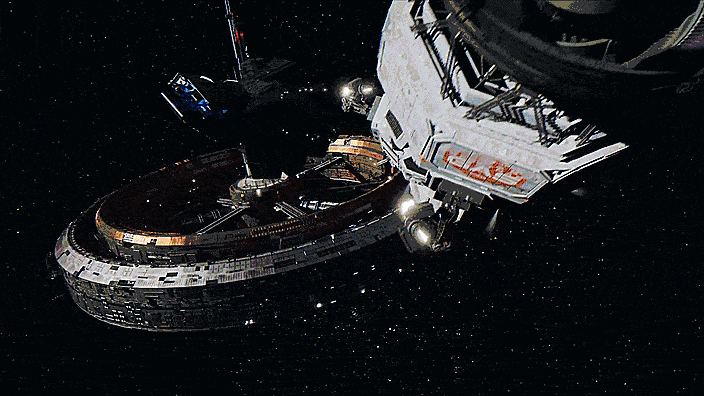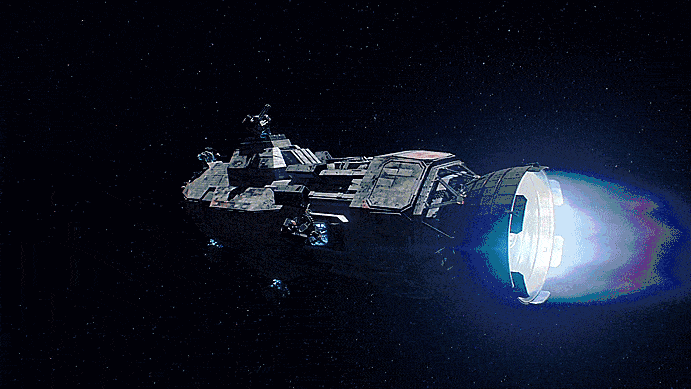Gravity is one of the underlying forces of the universe. What many people don’t think about is how fundamentally it has affected human physiology. Gravity affects our bone density, hormone levels, production of red blood cells, even the shapes of our eyes. It causes fluids to move into the lower parts of the body, which the heart compensates for by pumping it back upwards. Of course, most humans never have to think about that because they spend their entire lives planetside, never leaving the protective bubble of Earth’s atmosphere.
Astronauts who spend extended periods in space experience the side effects of weightlessness. Their muscles atrophy and they lose bone density; it’s called “spaceflight osteopenia.” They lose weight, especially bodily fluids. They also grow up to three-percent taller as their spines expand in microgravity.
The actual importance of gravity is something that is almost unanimously ignored in science fiction. Sometimes, it’s hand-waved away with mysterious technology like “artificial gravity” and “inertial dampeners.” More speculative shows could be argued to have more in common with the fantasy genre than science fiction and don’t even try to explain the physics away.
The Expanse is one of the very few shows that take a hard sci-fi approach to gravity. In the near future, humanity has colonized Mars, the Moon, and some of the asteroid belt. Earth and Mars vie for the power of the resources in the Belt while the Belter working class are fighting for independence from both. Some of the creators’ hard approach to sci-fi is explicit in the show when they explain how space travel works, or how the Belters acquired their physiology. Other aspects are much more subtle: small details in a scene that flesh out a (mostly) scientifically accurate futuristic society.
There are some clear reasons why the entire series cannot be defined as hard sci-fi. The sociopolitical tension in the system is heightened upon the first discovery of alien life. That mind-bending technology certainly wanders out of the realm of scientific explanation, but the depiction of gravity is one thing that they definitely got right.

Space travel is three-dimensional. “Up” and “down” is all relative. Gravity is complicated.
Growing up in low gravity has created an entire underclass of “Belters,” whose very physiology marks them as different from those who grew up “down a [gravity] well.” They are much taller and thinner and must take medications for their bones to grow properly. There is a constant need for resistance exercise to maintain muscle mass, especially for anyone who intends to go planetside. Many Belters would never be able to go to the surface of a planet after living their entire lives in low-gravity. Some Belters argue that these changes mean that they have branched off to become an entirely new human subspecies.

An Earther compares hand sizes with a Belter.
Belters live their lives in ships or on stations which are either owned by Earth or Mars governments or privately held. There are two primary ways that humans can create artificial gravity: thrust or spin. Earth gets its gravity from its enormous mass. Asteroids like Ceres or Eros are much less massive than Earth, so they don’t create enough gravity on their own. Instead, they utilize “spin gravity,” meaning that they get spun up to spin like a planet, but must faster. The centripetal acceleration creates a kind of gravity. Closer to the center of the station, the gravity is higher. Near the outside, the gravity is lessened, and there is a Coriolis effect.

The Coriolis Effect on Ceres Station is caused by spin gravity.
Ships, on the other hand, are designed like high-rise buildings to take advantage of thrust gravity; aerodynamics are mostly irrelevant in the resistance-free vacuum of space. Imagine the basement of the high-rise is the engine. The thrust that it creates pushes the ship forward, and anything loose within the ship (including people) would be “pulled” down onto the floors in a semblance of gravity. The faster the ship goes, the heavier the gravity there is.
The human body is primed for Earth’s atmosphere (called G), so heavy acceleration comes with serious risks. As astronauts grow taller in microgravity, jet pilots actually shrink after experiencing high-G acceleration. Most people can deal with up to 5G, while pilots and astronauts go through special training to deal with up to 9G. Under very high or extended high-G maneuvers, people faint, get brain damage, or die. In the end, human bodies are just flesh-bags of bones and liquid. If you accelerate (or decelerate) fast enough, those meat suits are going to get damaged.

Slingshot route that uses gravity assists to pick up incredible speed.
In Season 3, Episode 7, a Belter shoots his ship on a “slingshot” path towards the alien Ring structure. Slingshotting means using a single initial burn of the engines along a carefully planned trajectory. In passing near to planetary bodies, this ballistic ship can perform a gravity assist to pick up speed. Precise calculations are needed to prevent the ship from falling into the atmosphere or not picking up enough speed. It’s become a sport in the solar system, and the best slingshotters only use a single-engine burn to get all the way to their destination. Unfortunately, this pilot did not account for the alien technology of the Ring grabbing his ship and bringing it to an almost instantaneous stop. The result is…messy.

Unknown alien technology decelerates the ship Y Que from high speed to a near stop, to the misfortune of the pilot.
Speaking of our fragile human bodies, when you have gravity as a tool, you don’t need phasers, photon torpedos, or laser guns. Slugs of steel will punch holes through ships and people just fine. In The Expanse, Earth and Mars are the main military powers in the system, though the Belt is up and coming as an independent nation. The militaries use point-defense cannons (PDCs) or rail guns for close-quarters battle (CQB), and nuclear missiles, weaponry that is no different in theory from what we use today. There are no energy shields, either — if you’re hit, you’re hit. No Death Star is required to kill a planet, either. Accelerate big rocks fast enough, and they can cause planetary extinction-level events like the meteor that killed off the dinosaurs.

Note that the paths of the PDC rounds look curved because of the changing angle of the cannons. A nice detail
To make space even more complicated, ships also can’t maneuver too aggressively without harming their passengers. Everything on a ship must be secured when accelerating because, with enough inertia, any object can become an accidental projectile weapon.

Stow your gear before engaging in evasive maneuvers.
The cast and crew of The Expanse have taken the time to engage directly with the scientific community on multiple occasions. Author Ty Franck, showrunner Naren Shankar, and cast members Shohreh Aghdashloo, Cas Anvar, and Wes Chatham sat down with California Institute of Technology and JPL scientists to discuss some of the decisions that have gone into making the show as accurate as possible. Anvar and castmate Cara Gee starred in a NASA’s Universe of Learning video that explains the Goldilocks Paradox of habitable planets. After The Expanse was dropped by SyFy, the first announcement that Amazon would be picking up the show was made not through a press announcement or social media post but instead during an awards dinner at the National Space Society’s International Space Development Conference.
At the Caltech panel, Robert Hurt, an astronomer and visualization scientist at the IPAC group, said about the show:
“It’s hard to underestimate the impact the creative team behind a show can have by portraying science effectively in their narratives. So many current scientists today were in part inspired into their current careers by the shows they watched in their youth.”
The scientific accuracy of the show is not surprising considering the research that went into the source material, or that Shankar has graduate degrees in applied physics and electrical engineering. Hard science fiction is about more than just pleasing nerds; it’s about the impact that sci-fi can have on the larger discussions society has about science. The attention paid to that narrative and their active engagement with the scientific community shows how important that responsibility is to the cast and crew of The Expanse.
The post Gravity is a Real Bitch: Hard Science Fiction in ‘The Expanse’ appeared first on Film School Rejects.
0 comments:
Post a Comment